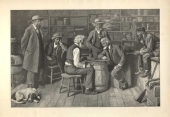The Checker Maven
The World's Most Widely Read Checkers and Draughts Publication
Bob Newell, Editor-in-Chief
Published every Saturday morning in Honolulu, Hawai`i
Noticing missing images? An explanation is here.
Elegance and Style

Little can match British architectural style and elegance as demonstrated in the photo above. Neither too simple nor too complex, blending historical charm with enduring utility, we can't help but be impressed. Yet in the world of draughts, for something comparable we always turn to the American master of checker problem elegance and style, Tom Wiswell. This week's offering is neither too difficult nor too easy, and combines charm and style with practicality and instructiveness. It's a tour-de-force of which few other than Mr. Wiswell would be capable. Here's the position.

WHITE
White to Play and Win
W:W13,31,32:B4,21,28.
Try your hand at this one, and then click on Read More for the solution and explanatory notes. Take your time and enjoy it to the fullest; it's sheer elegance on the draughts board.![]()
The 11-Man Ballot Game

Most of us--- we're talking about the casual, average checkerist here--- are very happy with "Go As You Please" (GAYP) checker play, in which the choice of opening moves is completely at our own discretion. We find more than enough challenge and entertainment in this most basic form of our game.
But, as we're sure most of you know, at the highest levels of play, GAYP tends to be drawish, and games tend to repeat, especially when the players are unwilling to take risks with a championship or prize at stake. That's why "2-move restriction" and later on, "3-move restriction" checker play came into being. In these forms of the game, the first two or three moves are chosen at random, by "ballot," and a pair of games is played from the chosen ballot, each player trying his luck at each side of the opening. The idea is to force the game into different lines of play and avoid drawish repetition.
Of course, the reason that 3-move restriction arose is that 2-move restriction play was highly analyzed and drawishness crept into even this form of the game. 3-move restriction, which is today the common mode of play at major tournaments, does somewhat better, but it too has been analyzed a great deal.
There is another form of play, invented many years ago by champion Newell W. Banks, which provides literally thousands of possible opening combinations, far too many to easily analyze, and certainly too many to memorize. That form of play is called "11-man ballot." In this game, a ballot is chosen which eliminates at random one man from each side (hence the 11-man idea) and then chooses the opening move for each side, just as in 2-move restriction. There are some limitations and additional rules, but we're sure you get the idea.
11-man ballot hasn't been very widely played. There have been a few 11-man ballot matches and tournaments, but not very many. Only recently have we seen revived interest in this form of play, with 11-man ballot games and tournaments taking place at the GoldToken internet site, and a recent live contest held in North Carolina and won by Tim Laverty. A match championship is scheduled for summer 2008 between Tim and reigning 3-move world champion Alex Moiseyev.
11-man ballot makes for exciting and often unpredictable play, as unusual starting positions require the players to exercise their over-the-board skills to a very high degree. It has much to recommend it and we'll guess that 11-man ballot has a renewed and bright future.
Today, though, let's go back in time to the classic 11-man ballot title match between champions Asa Long and Newell Banks. Here's one of the better games from that historical match, which took place many years ago.
| Black: Asa Long |
| White: Newell W. Banks |
| Ballot pieces off squares 6 and 24 |
| Two Move Ballot---9-13, 23-19 |
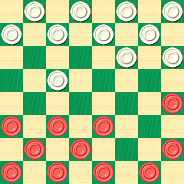
BLACK
Starting Position; Black to Play
| 9-13 | 23-19---a | 11-15 | 28-24 |
| 8-11 | 26-23 | 5-9 | 22-18 |
| 15-22 | 25-18 | 11-15---b | 18-11 |
| 7-16 | 29-25 | 9-14 | 25-22 |
| 1-5 | 22-18 | 16-20 | 18-9 |
| 5-14 | 23-18---c | 14-23 | 27-18 |
| 20-27 | 31-24 | 3-7 | 18-14 |
| 10-17 | 21-14 | 4-8 | 14-9 |
| 8-11 | 9-5 | 13-17---d | 5-1 |
| 7-10 | 24-20 | 11-15 | 32-28 |
| 15-24 | 28-19 | 17-22 | 1-5 |
| 2-7 |
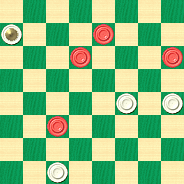
WHITE
White to Play and Win
W:W30,20,19,K5:B22,12,10,7.
Original notes are by Newell W. Banks.
a---Opens a beautiful position with the advantage to White, yet a sound defense seems possible.
b---Banks played 1-5 here against Long and should have drawn without much trouble.
c---Forms a magnificent ending which abounds with hidden possibilities.
d---7-10 looks best here and escapes with a narrow draw, thus 24-20, 11-15, 32-28, 15-24, 28-19, 20-16, 10-14, 6-1, 14-18, 1-6, 18-23, and Black just escapes.
Can you win the position shown above? Vote for your choice of move and then elect Read More to see the solution, the rest of the game, and additional explanatory notes.![]()
Down Low, Too Slow

Our site hosting performance has gone down low, and The Checker Maven has become too slow!
For the last little while, you've probably noticed that it can take a while to surf over to The Checker Maven. This is an issue with what is properly known as page loading time, and there have been some real problems. It's cost us a lot of readers as, after waiting for a while, they decide to go elsewhere or think our site is out of service.
We've tried working with our hosting company, but frankly, they've not been helpful. We think, though, that we've worked out the nature of the problem, and have put a fix in place. We'll know over the next few days if the fix has corrected the situation.
Meanwhile, we apologize if you're having problems with our site and thank you for your patience.![]()
McIndoe's Slingshot

In the right hands (or perhaps we should say in the wrong hands) a slingshot can be quite a fearsome weapon. In this month's installment from Willie Ryan's Tricks Traps and Shots of the Checkerboard, the Bronx Comet shows us how such a weapon can be used over the checkerboard. Willie credits his example to another Brooklyn great. Here's Willie to tell us about it.
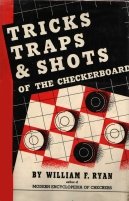
"When the tenability of a line of play depends on the execution of a timely shot at the last minute, just when it appears an impasse has been reached, the stroke attains its greatest scientific and artistic value. An unsurpassed example of such a climactic touch is bared in the time-tested gem presented on the next page, by the great Jim Mclndoe of yore, a Brooklyn, New York, boardmaster.
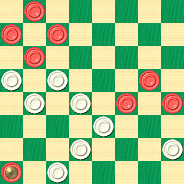
WHITE
White to Play and Draw
W:W13,14,17,18,23,26,28,30:B1,5,6,9,16,19,20,K29.
| 11-15 | 18-22 | 12-16 |
| 23-19 | 25-18 | 27-23 |
| 9-14 | 15-22 | 16-19 |
| 22-17 | 23-18 | 23-16 |
| 6-9 | 11-16 | 7-11 |
| 17-13 | 19-15 | 16-7 |
| 2-6 | 10-19 | 3-19 |
| 25-22 | 24-15 | 32-27 |
| 8-11 | 16-20 | 8-12---A |
| 29-25 | 17-14 | 27-23 |
| 4-8 | 22-25 | 12-16, |
| 22-17 | 21-17 | yielding the |
| 14-18 | 25-29 | diagrammed |
| 26-23 | 31-26 | position. |
A---If 8-11 is moved, a draw results from 18-15, 11-18, 14-10, 6-15, 13-6, 1-10, 27-23, 19-26, 30-7."
Can you solve this one? It's a little harder than some of the others in this series, but you can snap up the solution by clicking on Read More. We're sure you'll agree it's a dandy.![]()
Deans' Position

Um... hold on a minute here. Our column title refers to checkerist E. Deans, not to the famous actor James Dean. One of our editors must have been up late watching old movies, we suppose.
Rather than discussing the movies, though, our Checker School series heads back to some checker basics over the next few months. Today we present a lesson on Deans' Position. It's a classic example of the classic checker principle of mobility. Let's look at the diagram below.
WHITE
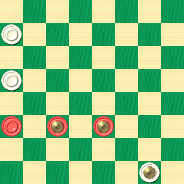
BLACK
Black to Play and Win
B:W28,20,K1:B12,K11,K10.
Black has slightly superior forces with two kings to White's one, but a definite advantage in mobility. The question is, of course, does Black have enough of an advantage to win? In this case, the answer is yes, but showing it is the problem. Can you do it?
Give this textbook position a try and then click on Read More for a detailed solution and several sample games. It's a practical lesson this month and one that you will use often in your own play.![]()
A Real-Life Checker Problem

Our photo above shows a real-life family enjoying a game of checkers, and in recognition of all the recreational checkerists out there, this month we've selected a simple speed problem drawn from real-life play. We've taken a position occurring in a game that took place on the GoldToken internet site; it shows the winning player taking advantage of an error that sets up a nice little play.
We think ten seconds is enough time to find the win. Click on the link below to show the problem and start our real-life clock.
March Speed Problem (easy)
Got it? Click on Read More to find the solution for real.![]()
The Devil and the Deep Blue Sea

We have to admit that last month's Fausto Dalumi problem was well into the "difficult" category. So this month, we'll feature a problem that is a little less strenuous. It was originally published under the theme "The Devil and the Deep" and we think you'll see why when you arrive at the solution.
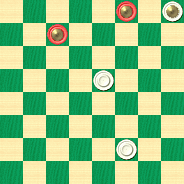
WHITE
White to Play and Win
W:W27,15,K4:BK6,K3
We don't think this problem will sink you, but if you find yourself bedeviled, just click on Read More and the solution will surface.![]()
Overlooked by Mail

Roughly once a month, we present an excerpt from Willie Ryan's undisputed classic work of checker tactics, Tricks Traps & Shots of the Checkerboard, and it's proven to be one of our most popular ongoing features. This time Willie turns to the world of postal play with a surprising game. Here's how Willie describes things.

"The similarity of formation and procedure between the preceding example (a Paisley Shocker) and the one ultimately reached in the accompanying game can be identified readily by comparing the two positions at the diagrammed stages. If there is any doubt in the reader's mind that champions are constantly overlooking winning strokes in their play, consider the circumstances in the case at hand. Two of America's foremost mail-game exponents--- Victor Davis, of Fort Dodge, Iowa, and George W. Bass, of Eaton, Colorado--- played this game by mail. When the diagrammed situation was reached, both contestants muffed the killer, the game ending in a draw.
| 10-15 | 27-20 | 1-5 |
| 24-19 | 4-8 | 30-25 |
| 15-24 | 17-13 | 3-8 |
| 28-19 | 2-6 | 22-17 |
| 9-14 | 31-27 | 14-18 |
| 22-18 | 8-11---A | 17-14 |
| 5-9 | 29-25---B | 11-15 |
| 25-22 | 10-15* | 20-16---C |
| 6-10 | 25-22 | 8-12 |
| 22-17 | 15-19 | 21-17---D. |
| 11-15 | 23-16 | See the |
| 18-11 | 12-19 | diagram. |
| 8-24 | 32-28 |

BLACK
Black to Play and Win
B:W28,27,26,25,17,16,14,13:B19,18,15,12,9,7,6,5.
A---Of course, 10-15 loses immediately by the in-and-outer via 21-17, 14-21, 30-25, 21-30, 20-16, 12-19, 23-16, 30-23, 27-2, 8-12, 16-11, 12-16, 29-25, 16-19, 32-27, etc., and white wins. Again at A, if black moves 1-5, white will win with: 23-18, 14-23, 27-18, 8-11, 29-25, 10-15, 26-22, 7-10, 21-17, 12-16, 32-27, 3-8, 30-26, 8-12, 18-14, 9-18, 26-23. Wm. F. Ryan.
B---23-18 would be no good now. For example: 23-18, 14-23, 27-18, 10-14, 26-23, 7-10, 29-25, 10-15, 25-22, 12-16, 32-28, 15-19, 30-26, 3-8, 18-15, 11-27, 20-4, 1-5, etc., and black wins. Wm. F. Ryan.
C---A safer route would be 21-17, 6-10*, 13-6, 19-24, 28-19, 15-31, 26-22, 8-12, 22-15, 10-19; a draw.
D---This is where Bass bogged down in the morass of formation. The move taken allows the thunderbolt that follows; but instead of 21-17, try 16-11*, 7-16, 26-22, 19-23, 14-10, 23-32, 10-1, 9-14, 22-17, for a draw. Wm. F. Ryan."
Don't get buried yourself. After you've tried to solve the position, dig your way out by clicking on Read More to see the solution.![]()
Saving the Game

In this month's lesson in our ongoing Checker School series, we learn a valuable lesson in saving the game; in other words, looking for a way to draw even when our position doesn't appear to have too many chances. Here's the position:
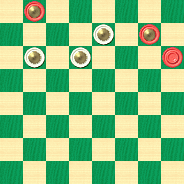
BLACK
Black to Play and Draw
B:WK26,K24,K23:BK32,K25,21.
This situation, attributed to a J. Cornock, does indeed look tough for the Black side, who have little mobility and a very narrow choice of moves. Yet, one of them is good enough to save the draw. Can you find it?
Give it a try but don't forget, you can always save time and frustration by clicking on Read More to see the solution, with detailed notes and a sample game.![]()
Faster Than Greased Lightning
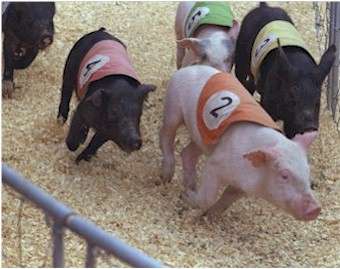
Our first set of speed problems for the year are truly worthy of the title. They both fall decidedly into the "easy" category, but as we know our readers enjoy a challenge, we're setting the time limits at record lows--- five seconds for the first problem and ten seconds for the second! We think this should satisfy everyone. Advanced players can try to sight-solve the problems in the rather strict time limits allotted. Less experienced players can simply look for the solutions and ignore the clock (well, yes, that is easier said than done).
Are you ready? Click below to start each problem--- faster than greased lightning!
February Speed Problem No. 1 (five seconds)
February Speed Problem No. 2 (ten seconds)
When you're finished, slide your mouse over and zap Read More to see the solutions.![]()
The Checker Maven is produced at editorial offices in Honolulu, Hawai`i, as a completely non-commercial public service from which no income is obtained or sought. Original material is Copyright © 2004-2026 Avi Gobbler Publishing. Other material is public domain, AI generated, as attributed, or licensed under CC1, CC2, CC3 or CC4. Information presented on this site is offered as-is, at no cost, and bears no express or implied warranty as to accuracy or usability. You agree that you use such information entirely at your own risk. No liabilities of any kind under any legal theory whatsoever are accepted. The Checker Maven is dedicated to the memory of Mr. Bob Newell, Sr.

